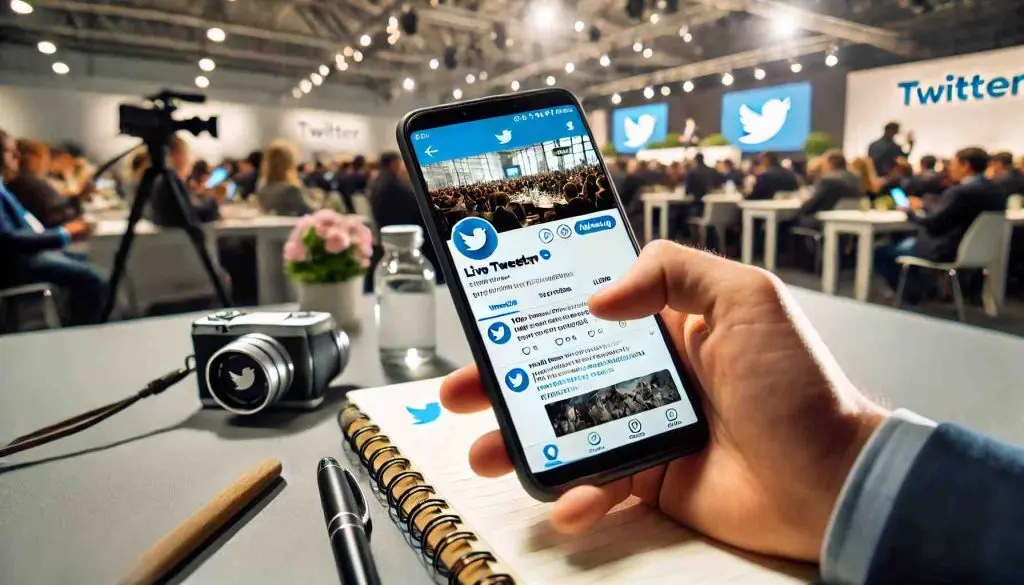Engagement on Twitter is all about how people interact with your content, like when you tweet a funny photo of your pet, and your notifications light up with likes, retweets, and comments.
But what does engagement mean on Twitter exactly? It’s more than just numbers – it’s a sign that your content is resonating with people and sparking interaction.
Why does it matter, and how can you make it work for you? Let’s dive in and explore what engagement really means in the world of Twitter (X).

What Does Engagement Mean On Twitter?
At its core, Twitter engagement is all the ways people interact with your tweets. It’s not just about likes, although those are nice.
Engagement includes retweets, replies, clicks, and even how often people share your content in private messages.
Think of Twitter engagement as a conversation. It’s a sign that people aren’t just scrolling past your tweets – they’re stopping, paying attention, and responding.
For example:
- If someone likes your tweet, they’re saying, “I agree!” or “I like this.”
- If they retweet, they’re sharing your message with their friends.
- Replies are like direct chats – they’re more personal and interactive.
- Link clicks show they’re interested enough to learn more.
Engagement, however, doesn’t happen on its own. It’s a two-way street. If your followers interact with you, it’s up to you to keep the conversation going.
Ignoring replies or comments can make your account feel impersonal.
Why is Engagement Important?
Tweet engagement is like proof that what you’re sharing matters to someone. On Twitter, this can have a ripple effect. Let’s break it down further:
More Eyes on Your Tweets
Twitter’s algorithm rewards tweets with high engagement. If people are liking, sharing, or commenting, your tweet is more likely to appear in other users’ feeds.
This is especially important if you’re trying to grow your audience.
Imagine you tweet a funny joke, and it gets 100 retweets. Those retweets mean 100 new groups of people are seeing your tweet – groups you might never have reached otherwise.
Building Trust
High engagement shows people care about what you’re saying. If someone stumbles upon your account and sees your tweets are lively and interactive, they’re more likely to follow you.
It’s social proof. People naturally gravitate toward what others are already engaging with.
Reaching New Twitter User
Every retweet or comment is an opportunity for someone new to discover you. Think of it as free advertising. If you’re a business, this can translate into new customers or clients.
Feedback
Engagement isn’t just a vanity metric. It’s also a way to gather insights. What do people like? What are they curious about? Their replies and interactions can guide your content strategy.
For example, if you tweet about two products and one gets significantly more replies or clicks, that’s a clear sign your audience prefers it. Use this data to adjust your approach.
Tweets with videos can get 10 times more engagement than those without. This shows how important it is to experiment with different types of content.
How to Measure Twitter Engagement
If you’re curious about how well your Twitter performance is, you need to look at engagement metrics. Here’s a quick guide:
Engagement Rate
This is the percentage of people who interact with your tweet after seeing it. To calculate it, divide the number of engagements by the number of impressions (how many people saw the tweet), then multiply by 100.
For example: If your tweet had 50 engagements and was seen by 1,000 people, your engagement rate would be 5%.
Most experts consider an average engagement rate between 0.5% and 1% decent for Twitter. If you’re getting above 1%, you’re doing better than most accounts.
Clicks
Clicks tell you how many people are interested enough to explore further. This could mean they’re clicking a link, your profile, or even an attached image.
Retweets vs. Replies
Retweets can increase your reach, while replies indicate deeper engagement. Both are important, but they serve different purposes. Monitor both to see how your audience is responding.
By understanding these metrics, you’ll know what’s working and what’s not. Use this information to tweak your content strategy and focus on what resonates most with your audience.
Use Twitter Analytics
Twitter Analytics is a powerful tool for understanding how your content performs and how your audience interacts with it.
It provides detailed insights into engagement metrics like likes, retweets, replies, link clicks, and impressions.
By tracking these numbers, you can identify which tweets resonate most with your audience and adjust your content strategy accordingly.
What Affects Engagement?
Not all tweets are created equal. Some grab attention, while others go unnoticed. Why? A few key factors influence how much engagement a tweet gets.
Content Quality
People interact with tweets that make them feel something. Humor, emotion, or helpful tips are usually winners. For instance, a funny meme or an inspiring quote can generate a lot of likes and shares.
Timing
Tweeting when your audience is online is crucial. Research suggests the best times to tweet are late mornings, lunchtime, or around 8-10 p.m. when people are winding down (Source: Sprout Social).
However, your audience might be different. Test and find your sweet spot.
Hashtags and Trends
Using trending hashtags or joining viral conversations can help your tweets get discovered by more people. But don’t overdo it. Tweets with too many hashtags can look spammy.

Consistency
Active social media accounts get more attention. Posting sporadically can make followers forget about you. Aim for at least one tweet a day to stay on their radar.
Visuals
Images, GIFs, and videos grab attention faster than text. Tweets with images get 150% more retweets than those without.
Tone and Language
Speak to your audience in a way they understand. If your tone is too formal or too casual, it might miss the mark. Pay attention to how your followers engage and adjust accordingly.
How to Boost Engagement on Twitter
If you’re struggling to get people to interact with your tweets, don’t worry, It happens to everyone. Here are some actionable tips to turn things around:
1. Boost Twitter Engagement with TweSocial
If you’re looking to increase your Twitter engagement quickly and effectively, we at Twesocial can help. By buying Twitter likes and views, you can give your tweets the visibility they need to stand out.
Buying Twitter retweets for higher engagement not only makes your content look more credible but also improves how it’s ranked by Twitter’s algorithm, helping you reach a larger audience.
2. Mix Up Your Content
If all your tweets look the same, your Twitter followers may lose interest. People love variety, so don’t just rely on plain text.
Use embedded media like photos, videos, GIFs, or even infographics to grab attention. Tweets with visuals tend to generate moreimpressions and engagement.
- Post a short video explaining a trending topic in your industry.
- Share a behind-the-scenes photo of your workspace.
- Create a humorous meme that reflects your brand’s personality.
Each type of content appeals to different segments of your audience. Diversifying your content not only keeps things fresh but also helps you reach a broader range of people within your target audience.
Use your social media strategy to plan and balance these content types effectively.
3. Be relatable
People love valuable content that feels personal or familiar – it’s what keeps them coming back. Sharing your experiences, stories, or even struggles can make your tweets more engaging.
For example, a tweet like, “What’s a childhood snack you wish was still around?” taps into nostalgia and often sparks heartfelt replies.
To go deeper, connect with youraudience by understanding their preferences and pain points. Are they parents? Gamers? Entrepreneurs? Tailor your tweets to resonate with their interests.
Using a tool like Twitter Analytics, you can track which relatable tweets get the most interactions and refine your approach over time.
4. Respond to Comments
Engagement on Twitter isn’t a one-way street. If someone replies to your tweet, take the time to respond. Whether it’s a simple “thank you” or a more detailed answer, your reply shows that you value their input.
This not only builds relationships but also boosts your tweets in the Twitter algorithm, increasing visibility.
For example, if someone comments on your post about a favorite childhood snack, you could respond with: “Yes! I loved those too. Do you remember the blue packaging?”
This kind of interaction invites more replies and keeps the conversation going.
Engaging with comments also signals to your target audience that your Twitter account is active and approachable, which encourages more people to interact with you.
5. Post Consistently
Consistency is key when it comes to maintaining an active Twitter account. Twitter moves much faster than other social media platforms, so you’ll need to post regularly to keep up.
Use tools like Buffer or Hootsuite to schedule tweets and maintain a steady presence.
A consistent posting schedule can also improve your average engagement rate because your Twitter followers will know when to expect new content.
If you’re unsure how often to post, start with 1-3 tweets per day and adjust based on audience response.
Remember to mix in seasonal or trending topics to stay relevant. For instance, tweeting about holiday traditions during December can resonate with your target audience and attract more interactions.
6. Test and Learn
Not every tweet will hit the mark, and that’s okay. Testing is a crucial part of improving your engagement rate.
Experiment with different times, tones, and tweet formats to see what resonates most with your Twitter users.
For example:
- Try posting during peak hours to see if it increases your Twitter impressions.
- Experiment with humor, storytelling, or inspirational quotes to gauge which tone your audience prefers.
- Use Twitter Analytics to track how different types of tweets impact your average engagement rates and adjust accordingly.
By analyzing these results, you’ll refine yourstrategy and create content that consistently performs well. Don’t be afraid to try something new – it’s all part of learning what works for your unique audience.
What’s the Role of Emotions in Engagement?
One thing people often overlook is the emotional aspect of engagement on Twitter. Tweets that trigger laughter, surprise, or even anger often perform better.
Why? Because emotions drive action. When people feel something, they’re more likely to respond, retweet, or comment.
For example:
- A funny meme can make people laugh and share it with friends.
- A touching story might inspire people to reply with their own experiences.
- A controversial statement could spark a debate in the comments.
Using emotions strategically can give your Twitter engagement a big boost.
The Power of Community on Twitter
Building a community is one of the best ways to increase engagement. When people feel like they’re part of something, they’re more likely to interact.
Here’s how to build a community:
- Follow and Interact: Engage with people who follow you. Like their tweets, comment, and retweet when relevant.
- Create Shared Experiences: Use relevant hashtags or start discussions that bring people together.
- Celebrate Milestones: Thank your followers when you reach goals, like 1,000 follower growth or 100,000 impressions.
When your audience feels valued, they’ll be more likely to engage with your content.

Conclusion
So, what does engagement mean on Twitter? It means making an impact. Whether you’re a brand, a creator, or just someone who loves tweeting, the goal is simple: share, connect, and grow.
Twitter engagement isn’t just about numbers. It’s about connecting with people, starting conversations, and sharing valuable content that matters.
Start small. Post something today and see how people respond. Every like, retweet, or comment is a step toward building your community. And who knows – your next tweet might just be the one that goes viral.
Keep experimenting, keep connecting, and remember: Twitter engagement is all about being part of the conversation.
Frequently Asked Questions
What is a Twitter engagement?
A Twitter engagement is any interaction someone has with your tweet. This includes likes, retweets, replies, link clicks, profile clicks, and shares. It’s a way to measure how people are responding to your content.
What’s the difference between impressions and engagements on Twitter?
Impressions show how many times your tweet was seen, while Twitter engagements track the actions people take, like clicking, replying, or retweeting. Impressions measure visibility, and engagements measure interaction.
What does engaged mean on Twitter?
On Twitter, “engaged” means a user interacted with your tweet in some way. This could be liking, retweeting, replying, clicking a link, or even sharing it privately.
What is a good engagement rate on Twitter?
A good engagement rate on Twitter is typically between 0.5% and 1%. If your Twitter engagement rate is above 1%, you’re performing better than most accounts. The higher, the better, as it shows strong audience interaction.


